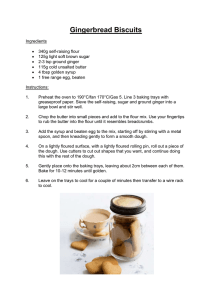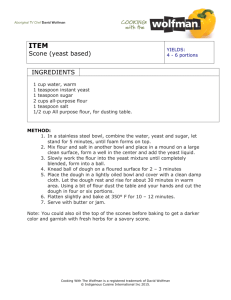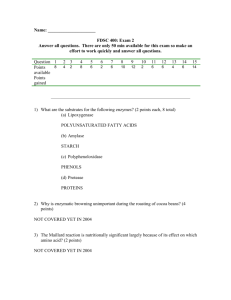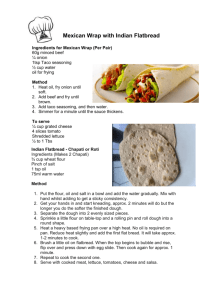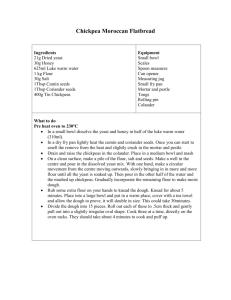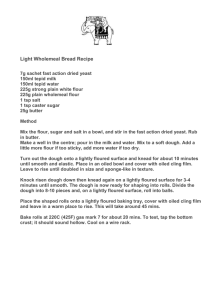Advance Journal of Food Science and Technology 5(8): 1011-1014, 2013
advertisement
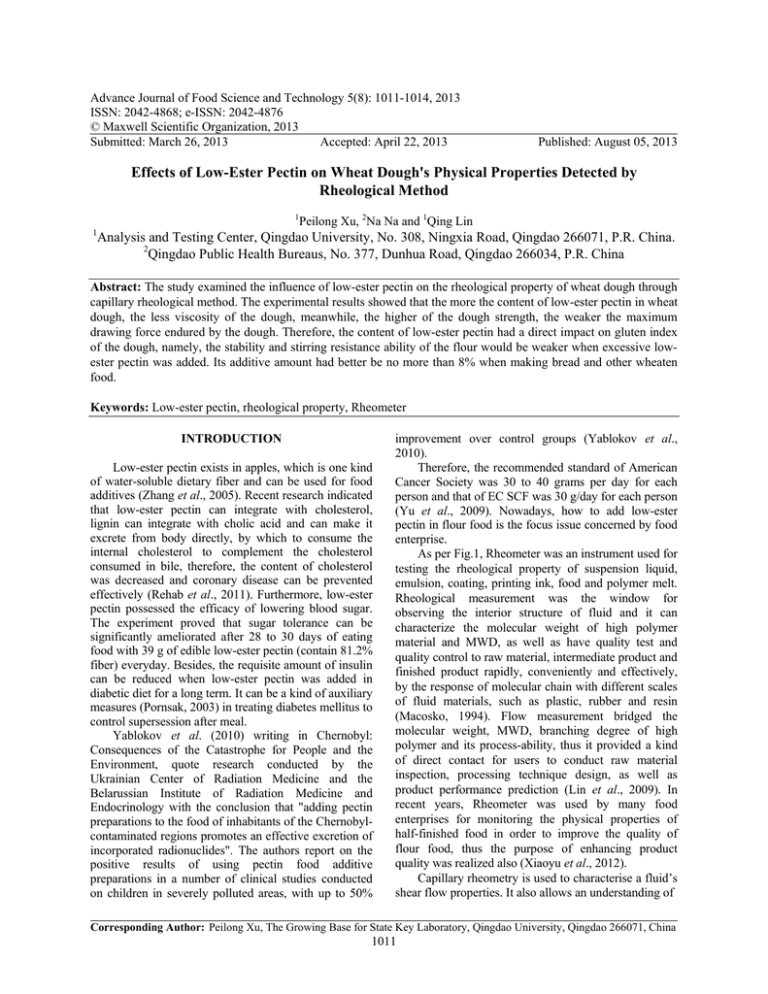
Advance Journal of Food Science and Technology 5(8): 1011-1014, 2013 ISSN: 2042-4868; e-ISSN: 2042-4876 © Maxwell Scientific Organization, 2013 Submitted: March 26, 2013 Accepted: April 22, 2013 Published: August 05, 2013 Effects of Low-Ester Pectin on Wheat Dough's Physical Properties Detected by Rheological Method 1 Peilong Xu, 2Na Na and 1Qing Lin 1 Analysis and Testing Center, Qingdao University, No. 308, Ningxia Road, Qingdao 266071, P.R. China. 2 Qingdao Public Health Bureaus, No. 377, Dunhua Road, Qingdao 266034, P.R. China Abstract: The study examined the influence of low-ester pectin on the rheological property of wheat dough through capillary rheological method. The experimental results showed that the more the content of low-ester pectin in wheat dough, the less viscosity of the dough, meanwhile, the higher of the dough strength, the weaker the maximum drawing force endured by the dough. Therefore, the content of low-ester pectin had a direct impact on gluten index of the dough, namely, the stability and stirring resistance ability of the flour would be weaker when excessive lowester pectin was added. Its additive amount had better be no more than 8% when making bread and other wheaten food. Keywords: Low-ester pectin, rheological property, Rheometer INTRODUCTION Low-ester pectin exists in apples, which is one kind of water-soluble dietary fiber and can be used for food additives (Zhang et al., 2005). Recent research indicated that low-ester pectin can integrate with cholesterol, lignin can integrate with cholic acid and can make it excrete from body directly, by which to consume the internal cholesterol to complement the cholesterol consumed in bile, therefore, the content of cholesterol was decreased and coronary disease can be prevented effectively (Rehab et al., 2011). Furthermore, low-ester pectin possessed the efficacy of lowering blood sugar. The experiment proved that sugar tolerance can be significantly ameliorated after 28 to 30 days of eating food with 39 g of edible low-ester pectin (contain 81.2% fiber) everyday. Besides, the requisite amount of insulin can be reduced when low-ester pectin was added in diabetic diet for a long term. It can be a kind of auxiliary measures (Pornsak, 2003) in treating diabetes mellitus to control supersession after meal. Yablokov et al. (2010) writing in Chernobyl: Consequences of the Catastrophe for People and the Environment, quote research conducted by the Ukrainian Center of Radiation Medicine and the Belarussian Institute of Radiation Medicine and Endocrinology with the conclusion that "adding pectin preparations to the food of inhabitants of the Chernobylcontaminated regions promotes an effective excretion of incorporated radionuclides". The authors report on the positive results of using pectin food additive preparations in a number of clinical studies conducted on children in severely polluted areas, with up to 50% improvement over control groups (Yablokov et al., 2010). Therefore, the recommended standard of American Cancer Society was 30 to 40 grams per day for each person and that of EC SCF was 30 g/day for each person (Yu et al., 2009). Nowadays, how to add low-ester pectin in flour food is the focus issue concerned by food enterprise. As per Fig.1, Rheometer was an instrument used for testing the rheological property of suspension liquid, emulsion, coating, printing ink, food and polymer melt. Rheological measurement was the window for observing the interior structure of fluid and it can characterize the molecular weight of high polymer material and MWD, as well as have quality test and quality control to raw material, intermediate product and finished product rapidly, conveniently and effectively, by the response of molecular chain with different scales of fluid materials, such as plastic, rubber and resin (Macosko, 1994). Flow measurement bridged the molecular weight, MWD, branching degree of high polymer and its process-ability, thus it provided a kind of direct contact for users to conduct raw material inspection, processing technique design, as well as product performance prediction (Lin et al., 2009). In recent years, Rheometer was used by many food enterprises for monitoring the physical properties of half-finished food in order to improve the quality of flour food, thus the purpose of enhancing product quality was realized also (Xiaoyu et al., 2012). Capillary rheometry is used to characterise a fluid’s shear flow properties. It also allows an understanding of Corresponding Author: Peilong Xu, The Growing Base for State Key Laboratory, Qingdao University, Qingdao 266071, China 1011 Adv. J. Food Sci. Technol., 5(8): 1011-1014, 2013 Fig. 1: Melt Flow Index (MFI) equipment and screw-driven capillary rheometer the way fluids flow in variable cross-section geometries. Fluid flow lies at the centre of all extrusion processes, whether batch or continuous. This includes the dispensing of adhesives and other paste and fluid materials. Adhesive materials used in manufacture are becoming more complex in terms of their rheology and ever more complex dispensing processes are being introduced. The study mainly made a research on the influence of low-ester pectins additive on dough rheological property and provided essential data for wheat flour manufacturing enterprises in how to make the best choice of additive amount, by making comparisons of different impact effects of low-ester pectins addictive to dough rheological property when being added with different volumes, thereby, the food processing technique of flour enterprises can be enhanced and its production quality can be improved also. MATERIALS AND METHODS Material and equipment: Flour: Superfine first-class flour, made in Beijing Guchuan Flour Co., Ltd, with moisture content of ≤14.5%; precipitation number of 30-45mL. Food additives: low-ester pectin powder, loss on drying of ≤8%; acid-insoluble ash of ≤1%; ph (1% aqueous solution) 4.5-5.4; sulfur dioxide of ≤0.005%; total galacturonic acid of ≥65%. Quality standard: GB 25533-2010, Zhengzhou Chengwang Chemical Industry Co., Ltd. Capillary Rheometer: RHEO-TESTER 2000 type Capillary Rheometer, HAUL-OFF Extensional Rheometer, German Göttfert Company. Testing site: Chemistry and biology laboratory of Analysis and testing center, Qingdao University. Testing date: Jan. 14th, 2013 - Jan. 16th, 2013. Testing Methods: The preparation of experimental sample: Take out four beakers and filled them with 50 g flour and 60 mL distilled water separately; add 2 g, 4 g and 8 g low-ester pectins powder into three beakers of them, respectively, stir the liquid with glass rod for 5 min till it became well-distributed paste; mark them four as A, B, C, D for distinction after 30 min of fermentation. Rheological property test: Set the barrel temperature of Capillary Rheometer as 37°C regulate the initial value of the descent velocity of piston as 0.1 mm/s, multiplication rate as 2, mouth-model diameter as 2.0 mm. The sampling points received were shown in Table1. The experiment showed the change conditions and trends of flour stickiness along with the change of additive amounts of low-ester pectins. Tensile test: Demarcate HAUL-OFF Extensional Rheometer with 1 N weight and set the barrel temperature as 37°C. Squeeze out the tested sample 1012 Adv. J. Food Sci. Technol., 5(8): 1011-1014, 2013 Table 1: Rheological property test sampling points Piston descent Sampling points velocity mm/s F1 0.1 F2 0.2 F3 0.4 F4 0.8 F5 1.6 F6 3.2 F7 6.4 F8 12.8 RESULTS AND DISCUSSION Shear rate 1/s 22 45 90 180 360 720 1440 2880 Capillary Rheometer test result: As per Fig. 2, there exist obvious negative correlation between the flour stickiness property and low-ester pectins content. Flour stickiness would be lower and lower along with the low-ester pectins content became more and more. Gluten index would be one of the significant indexes during flour products process, which can better reflect the processing quality of flour products. The higher of gluten index, the stronger the gluten strength would be and the larger the volume of the baked flour products, while, there exist prominent negative correlation between flour stickiness and gluten index (Cheickna and Hui, 2011). Data demonstrated that the higher the content of low-ester pectins, the stronger the flour stickiness would be. from capillary tube in uniform velocity and regulate the pneumatic wheel revolving speed of HAUL-OFF Extensional Rheometer as the same as the squeezing speed of barrel. The experiment can be finished till the sample was snapped along with the gradual increase of pneumatic wheel speed. The main test indexes of the experiment were as follow: Anti-extension resistance: Reflect the anti-stretch ability of flour when being drawn and also was the essential index showing the power of gluten strength. Extensional Rheometer test result: In accordance with Table 2, the intensity of dough can be changed along with the increase of low-ester pectins, that the maximum drawing force it can bear was becoming weak with the increase of the addictive amount. The energy being consumed when the dough reached to maximum drawing force decreased largely also, but there was no obvious influence to stretch time owing to that the anti-extension resistance decreased Extensibility: it indicated the swelling power of gluten matrix. Paste was easy to be stiff and crack when the proportion of anti-extension resistance to extensibility was far too bigger, which made an impact on the volume and composition of wheaten food products (Jianhui et al, 2013). 4.00E+02 Not to add 8% 4% 16% 3.50E+02 Viscosity (Pa*S) 3.00E+02 2.50E+02 2.00E+02 1.50E+02 1.00E+02 5.00E+01 0.00E+01 F1 F2 F3 F4 F5 F6 F7 F8 Sampling point Fig. 2: Stickiness changing cure after being added different contents of low-ester pectins Table 2: Extensional rheometer test result Content (%) 0 4 8 16 Snap energy consumption (J) 5.31 3.27 2.92 2.68 Max drawing force (N) 46.84 45.63 41.15 36.34 Snap time (S) 16.24 15.89 16.11 16.04 Young modulus (×104N/m2) 7.6 7.2 6.9 6.5 after adding low-ester pectins, while there was no significant change of extensibility. CONCLUSION The flow behavior of wheaten dough adding with low-ester pectin belongs to non-Newtonian fluid, 1013 Adv. J. Food Sci. Technol., 5(8): 1011-1014, 2013 however, the increase of liquidity characteristic index illustrated that its non-Newtonian fluid behavior weakened and its Newtonian fluid behavior strengthened. There exists direct influence of low-ester pectins content to paste gluten index. The dough stickiness was stronger when it was with little low-ester pectins content, which was useful for making food with hard mouth-feel (Frederiksen et al. 2008). The dough stickiness was gradually decreasing when the low-ester pectins content was increasing, so the gluten strength enhanced in some degree and the mouth-feel of doughy wheaten food became soft. The addictive amount had better not surpass 8% when making bread and other flour foods. The increase of low-ester pectins content can impact the proportion of dough anti-extension resistance to extensibility. The stability and stirendurance ability of dough weakened to some extent after being filled with too much low-ester pectins. REFERENCES Cheickna, D. and Z. Hui, 2011. Physico-chemical properties and antioxidant activities of dietary fiber derived from defatted rice bran. Adv. J. Food Sci. Technol., 3(5): 339-347. Frederiksen, P.D., M. Hammershj, M. Bakman, A. PerNyegaard and B.A. Jens, 2011. Variations in coagulation properties of cheese milk from three Danish dairy breeds as determined by a new free oscillation rheometry-based method. Dairy Sci. Technol., 91(3): 309-321. Jianhui, B., L. Jinghui, Z. Na, S. Rula and J. Linxi, 2013. Effect of salt stress on antioxidant enzymes, soluble sugar and yield of oat. Adv. J. Food Sci. Technol., 5(3): 303-309. Lin, Z., M. Wang and Z. Wu, 2009. The relation between different wheat protein character indexes and the food processing-rheological characteristic indexes. Grain Process., 34(6): 16-18. Macosko, C.W., 1994. Rheology: Principles, Measurements and Applications. Wiley-VCH, New York. Pornsak, S., 2003. Chemistry of pectin and its pharmaceutical uses: A review. Silpakorn Univ., Int. J., 3(1-2): 206-228. Rehab, F.M.A., A.M. El-Anany and A.M. Gaafar, 2011. Effect of potato flakes as fat replacer on the quality attributes of low-fat beef patties. Adv. J. Food Sci. Technol., 3(3): 173-180. Xiaoyu, Z., T. Qun-Yi and R. Fei, 2012. Manuscript title: Influence of glucose, sucrose and trehalose on the freeze-thaw stability of tapioca starch gels. Adv. J. Food Sci. Technol., 4(4): 225-230. Yablokov, A.V., B.N. Vassily, V.N. Alexey and D.S.N. Janette, 2010. Chernobyl Consequences of the Catastrophe for People and the Environment. John Wiley and Sons, New York, pp: 304-309. Yu, Y., Z. Wang and N. Na, 2009. Effect evaluation of Olympic sailing events food safety traceability system and food hygiene security. J. Qingdao Univ., Med. College, 45(5): 480-482. Zhang, H., J. Tian and Y. Liu, 2005. Relevant research on dough stickiness with the main quality indexes of flour. Chinese Agri. Sci. Bull., 21(2): 69-71. 1014

